Key takeaways:
- Selective mutism is a complex anxiety disorder, causing individuals to speak comfortably in some situations but remain silent in others due to fear of judgment.
- Group settings can promote communication skills and foster connections, as individuals often feel more comfortable sharing experiences with peers facing similar challenges.
- Establishing trust, using active listening, and implementing structured turn-taking are effective strategies for encouraging participation in group discussions.
- Creating inclusive environments involves ensuring safety, utilizing visual aids, and being mindful of non-verbal cues to enhance communication among participants.
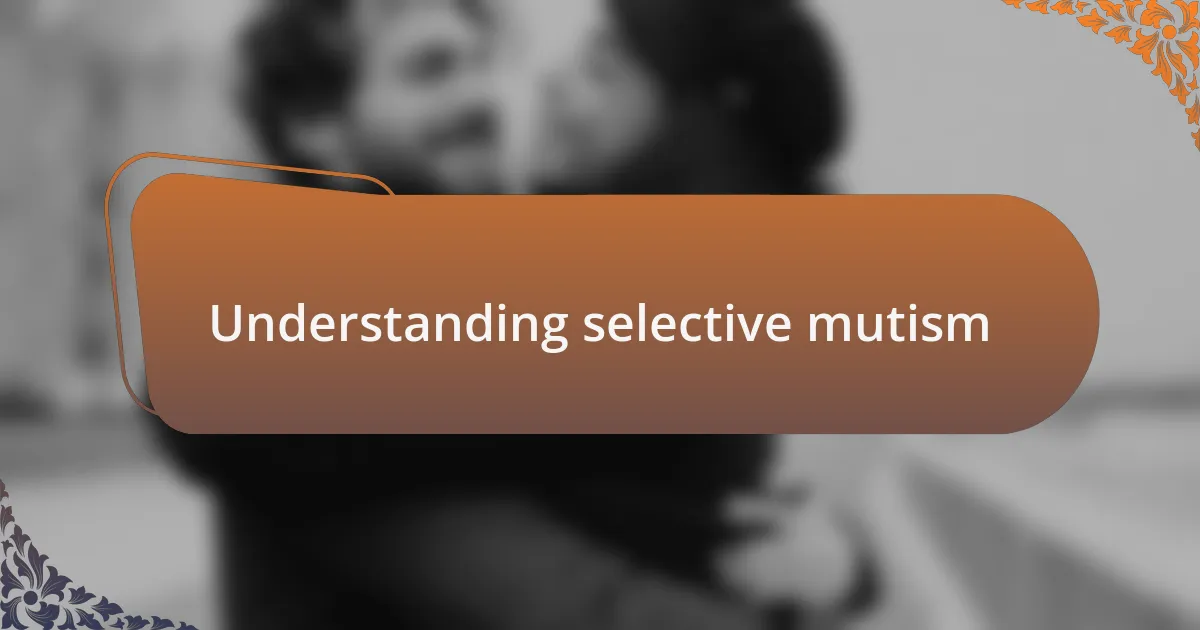
Understanding selective mutism
Selective mutism is not simply about being shy; it’s a complex anxiety disorder that affects a person’s ability to speak in certain social situations, despite being able to communicate comfortably in others. I remember meeting a little girl who could easily chat with her family at home but turned silent in the classroom. It made me wonder how many others live in that quiet struggle every day.
At its core, selective mutism often stems from a deep-rooted fear of judgment or rejection, leaving individuals trapped in silence. I’ve seen how this fear can create a barrier not just in speaking but also in forming connections with peers. How heartbreaking is it to see someone wanting to be heard but feeling like their voice is locked away?
Even though it can be frustrating for both the person experiencing selective mutism and those around them, understanding is the first step toward compassion. I recall supporting a friend who had this condition, and the relief I felt when we found simple ways for her to express herself without pressure. Isn’t it amazing how a little patience and empathy can open up a world of communication for someone struggling in silence?
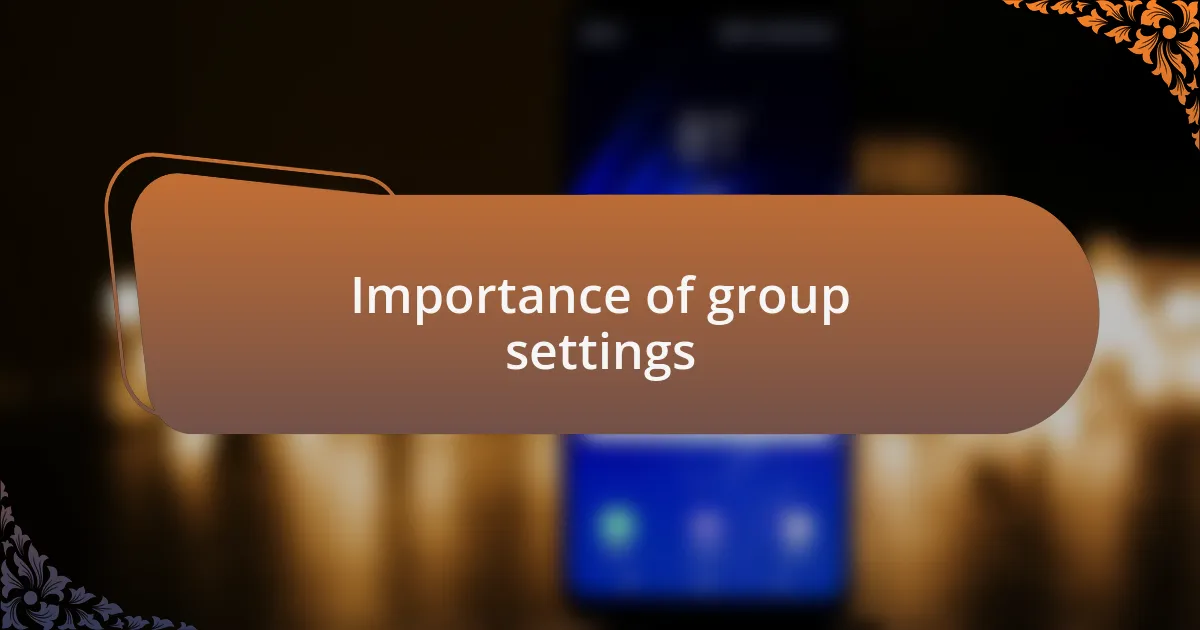
Importance of group settings
Group settings play a crucial role in the development of communication skills for individuals with selective mutism. I remember facilitating a small, supportive gathering where each participant took turns sharing their thoughts. It was remarkable to witness how the shared experience gradually encouraged some to voice their feelings, illustrating how a nurturing environment can erode the walls of silence.
Furthermore, in group settings, individuals often find solace in knowing they are not alone in their struggles. I once observed a young boy who rarely spoke, yet when he saw others facing similar challenges, he began to open up. It made me realize how powerful connection can be, transforming isolation into a network of understanding.
Engagement within a group fosters not just speaking but also listening and empathy—a vital part of communication. When I think back to my own experiences, participating in group activities was more than just practice; it was about learning to trust others. How often do we undervalue the impact of shared experiences in breaking down barriers?
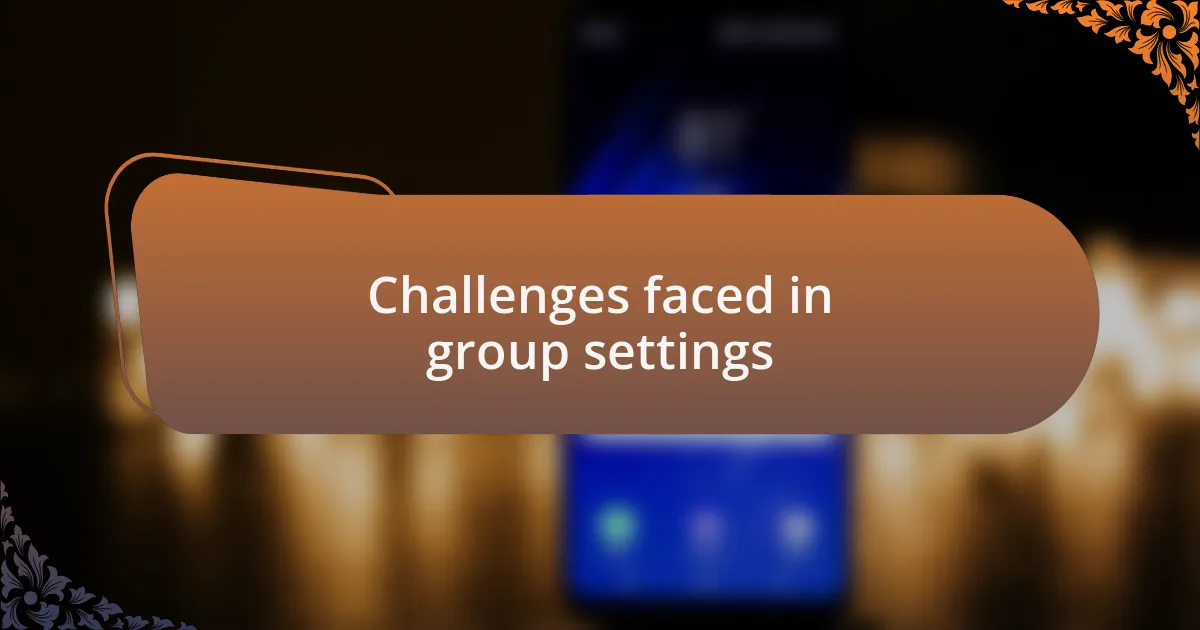
Challenges faced in group settings
In group settings, one of the most significant challenges faced is the overwhelming anxiety that can arise when individuals are surrounded by peers. I distinctly remember a time when a new participant was visibly distressed, unable to join in the conversation. It struck me how just the act of being part of a group could feel so daunting, illustrating a barrier that many experience. Why does an environment meant for connection often feel so threatening?
Another hurdle is the diverse range of comfort levels in speaking among group members. I once facilitated a session where one participant, a shy girl, would only nod or shake her head when asked questions. This contrast can sometimes create an imbalance, making those who struggle more with self-expression feel even more isolated. It begs the question—how do we create an equitable space where everyone feels capable of sharing?
Lastly, the fear of judgment or misunderstanding can loom large in group interactions. I recall a situation where a participant hesitated to express their thoughts out of concern that others might not understand or accept them. This fear can stifle communication, making it essential for group leaders to foster an accepting atmosphere. How can we actively encourage vulnerability to help participants overcome this fear?
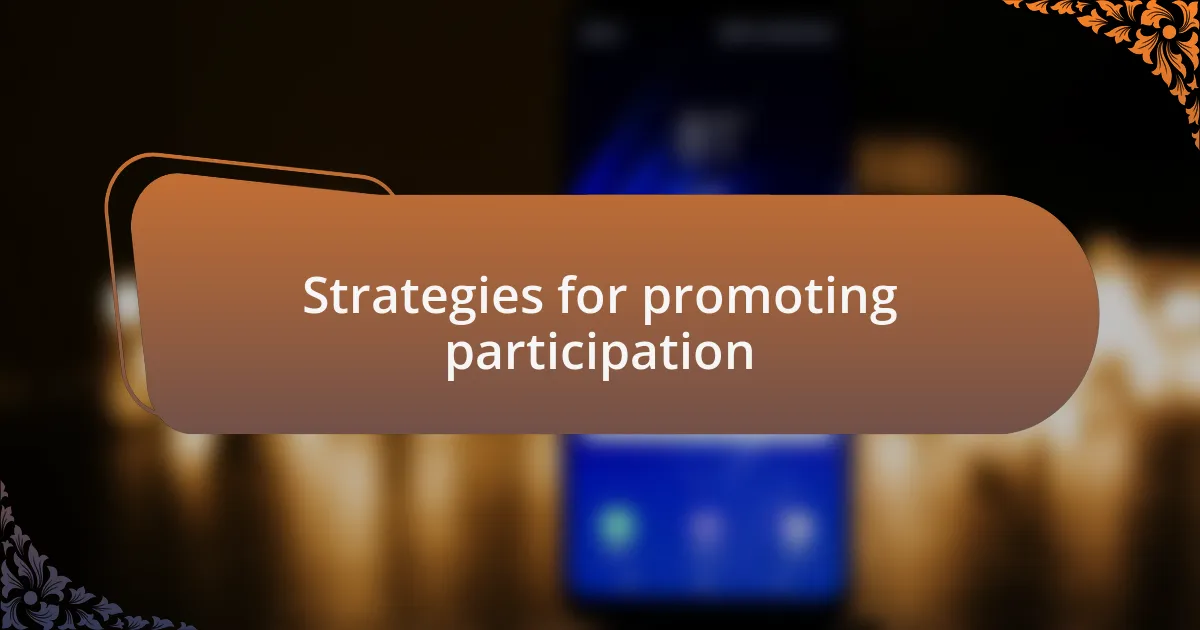
Strategies for promoting participation
Creating an environment that encourages participation starts with establishing trust within the group. I remember once introducing icebreaker activities that allowed participants to share lighthearted facts about themselves. This simple approach removed some of the initial apprehension and invited everyone into a more relaxed state, making it easier to open up. What if a few well-placed activities could make all the difference in fostering camaraderie?
One tactic that resonated with me was the practice of active listening. During discussions, I intentionally made eye contact and reflected back what participants shared, which helped them feel heard. It was remarkable to see how this validation could inspire someone to contribute their thoughts, even if they started timidly. Have you ever noticed how much a little encouragement can spark someone’s voice?
Additionally, structured turn-taking became a vital strategy in my group settings. This approach ensured that everyone had a dedicated moment to share without the pressure of interruptions. I distinctly recall a shy participant who blossomed when they realized their turn was coming up. By creating a predictable rhythm, the anxiety of speaking in a group transformed into anticipation. Isn’t it fascinating how structure can provide the comfort needed to break through barriers?
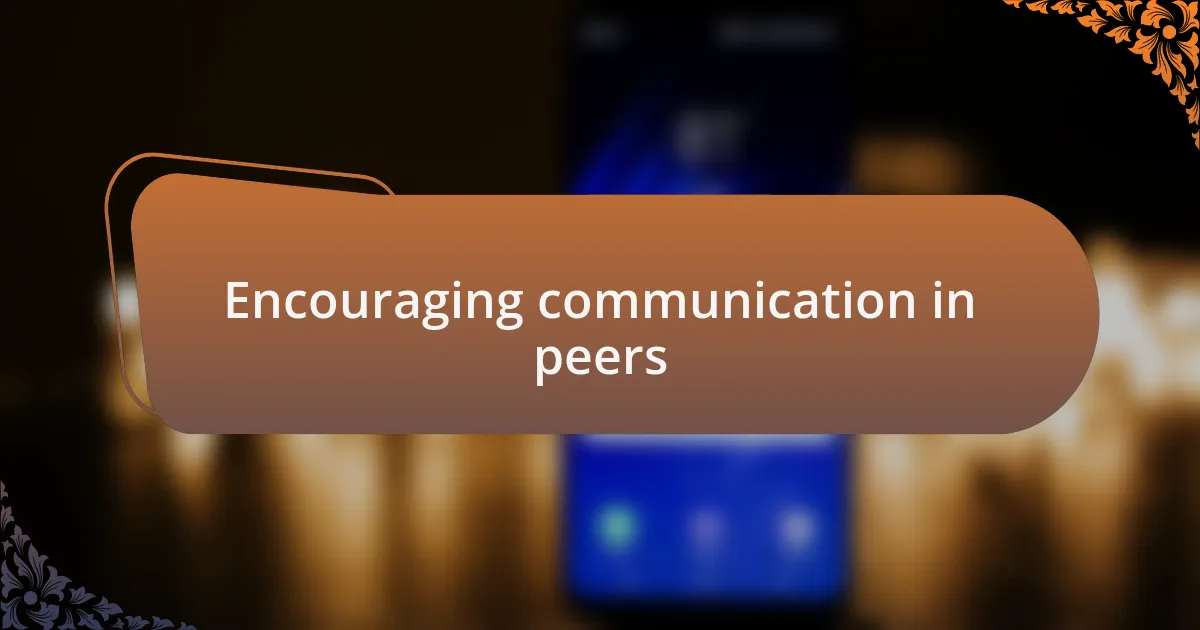
Encouraging communication in peers
Encouraging communication among peers often hinges on cultivating a supportive atmosphere. I once observed a subtle yet profound moment during a group discussion when a participant began to share a story from their childhood. Their peers leaned in closer, visibly engaged, which seemed to bolster their confidence. Isn’t it amazing how a little curiosity and attention can transform hesitation into enthusiasm?
I’ve found that using small group discussions can be particularly effective in sparking communication. After breaking into pairs, I noticed that quieter members felt more at ease sharing their thoughts. The intimacy of the smaller setting seemed to melt away some of their anxiety. Have you ever tried a format that lends itself to more personal exchange? The magic often lies in how the dynamics shift when it’s just a few voices instead of a crowd.
Furthermore, celebrating small victories within communication can significantly impact the group’s morale. I remember acknowledging when someone spoke up, no matter how brief their input was. The joy on their face was palpable, and it sent a ripple effect throughout the group, inspiring others to express themselves too. How rewarding it is to witness growth in real-time! Encouraging peer communication is about recognizing those fleeting moments of bravery that can pave the way for deeper connections.
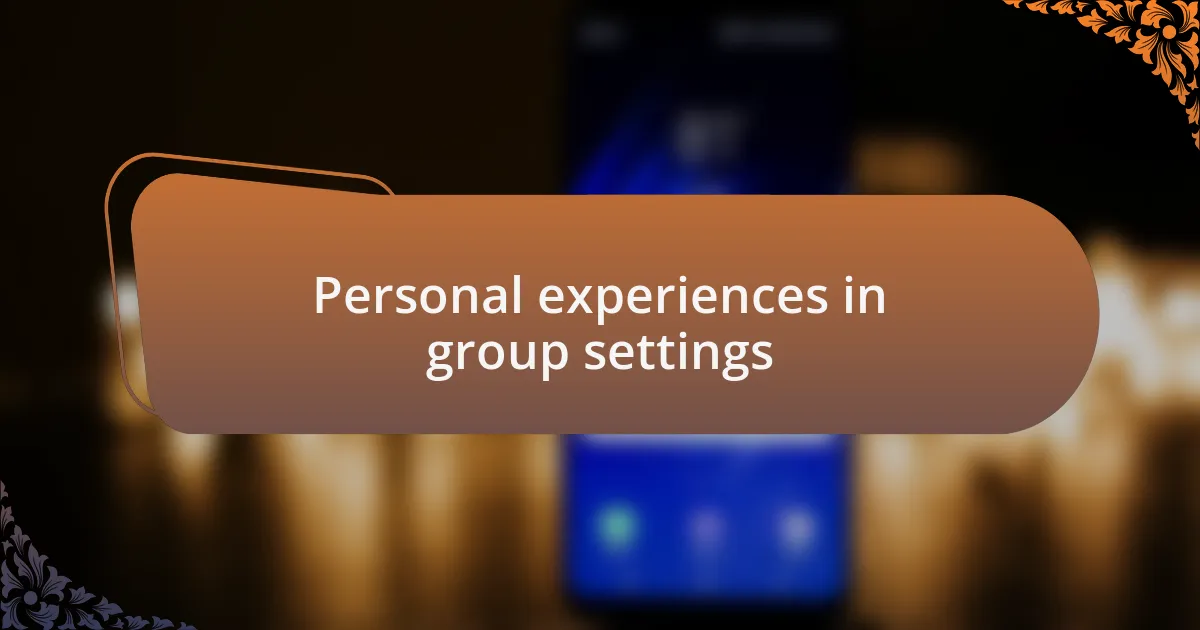
Personal experiences in group settings
Being in a group setting can be daunting, especially when I think back to my first experiences with it. I remember vividly a small circle of chairs surrounding a table, where I was expected to contribute but felt trapped in silence. My heart raced, and I wondered if anyone else felt the same knot of anxiety. That shared discomfort created an unspoken bond, reminding me that I was not alone in my struggle.
In another instance, facilitating a group project helped open doors for communication. I took a step back and allowed quieter participants to lead discussions on their ideas. It was enlightening to see how they lit up when given a chance to guide the conversation. Have you ever noticed how empowering it can be to make space for others? That practice not only benefited them but also deepened my understanding of collaborative dynamics.
I’ve also experienced moments in larger group settings where connections can feel superficial. Once, during a community event, I felt invisible despite the crowd. It dawned on me how crucial it is to foster genuine interactions. I realized that every voice matters, and creating opportunities for everyone to speak, no matter how small, can transform a sea of faces into a supportive community. Isn’t it incredible how those seemingly minor adjustments can make a world of difference?
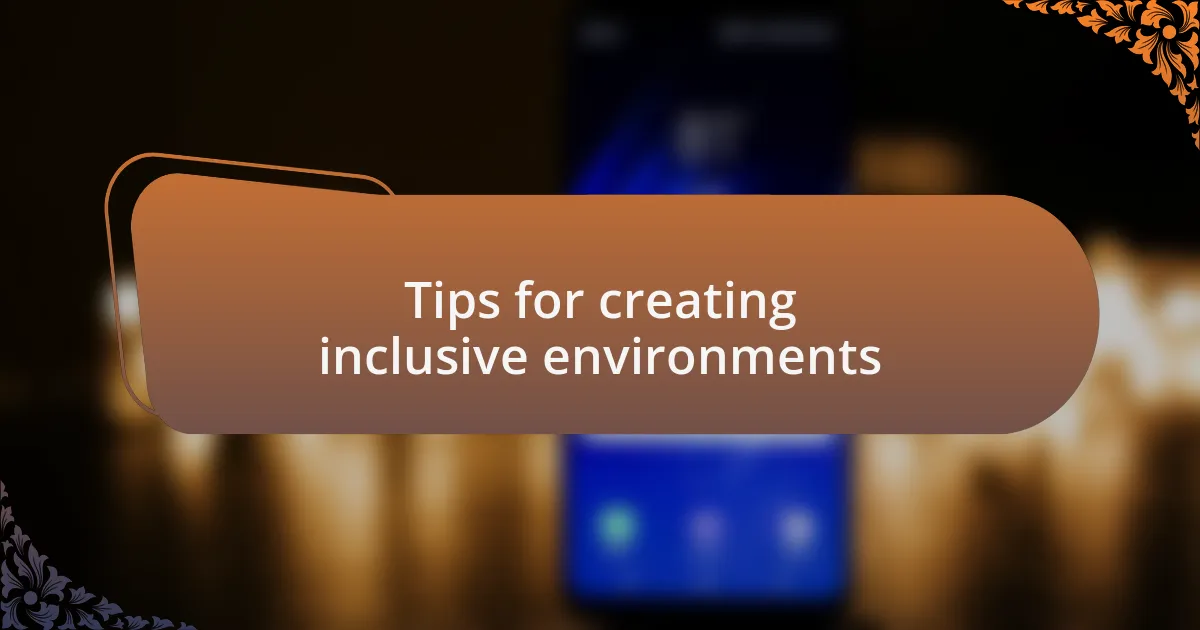
Tips for creating inclusive environments
Creating an inclusive environment starts with establishing a sense of safety. I remember attending a workshop where the facilitator encouraged everyone to share their names and a fun fact about themselves. The pressure was off because it wasn’t solely about speaking up; it was about connecting through shared experiences. Have you ever noticed how well this simple act can break the ice and make it easier for quiet individuals to engage?
Another effective strategy is using visual aids and interactive tools. I once participated in a brainstorming session where we used sticky notes to express our ideas anonymously. This method allowed me to contribute without the immediate fear of judgment. It was empowering to see my thoughts represented alongside others, creating a collaborative atmosphere. How often do you think such techniques are overlooked in group settings?
Lastly, being mindful of body language and non-verbal cues can significantly enhance inclusivity. During a team meeting, I made it a point to nod and maintain eye contact with a quieter colleague who seemed hesitant to speak. It was amazing to witness how this small gesture gave them the confidence to share their insights. Have you tried tuning into the unspoken communication in your groups? Understanding these subtle dynamics can unlock deeper connections and foster inclusivity.